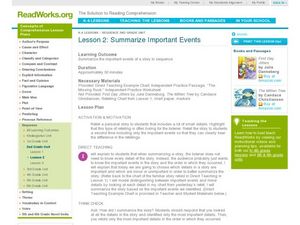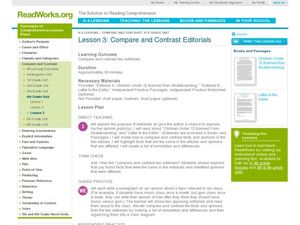Curated OER
Summarize Important Events
Second graders discover how to properly summarize important events. For this summarizing lesson, 2nd graders listen to a retelling with a lot of minor details and discuss how it could be improved. Students read a story and determine the...
Curated OER
Implicit Setting
Young scholars draw the setting of a story. In this setting and context clues lesson, students learn how to use textual clues to determine and visualize the setting of stories. Young scholars discuss the context clues they use to...
Curated OER
Lesson 1: Author's Voice in a Poem
Second graders use the title and text clues from a poem to determine what the author's voice is. In this author's voice instructional activity, 2nd graders participate in a directed instructional activity using the poem "Amazing Bats."...
Curated OER
Author's Voice in Passage
Students explore author's voice. In this literary elements and reading comprehension lesson, students listen to two poems about snakes (included) and identify adjectives and other descriptive words and phrases that help them determine...
Curated OER
Implicit Effects
Third graders describe cause and effect. In this implicit effects lesson students name the implicit effects in the story Two Ways to Count to Ten: A Liberian Folk Tale by Ruby Dee. Students analyze the story to find details to support...
Curated OER
Answering a Research Question
Students explore beginning research skills. In this nonfiction comprehension and research lesson, students generate possible research questions to answer when given the book title of Animals of the Sea and Shore by Ann O. Squire....
Curated OER
Lesson 1: Using Compare and Contrast Key Words
Third graders compare and contrast two things. In this comparing lesson, 3rd graders see vocabulary words used when comparing or contrasting two items. They read the story Alligators and Crocodiles by Trudi Strain Trueit and write a...
Curated OER
Compare and Contrast Settings
Third graders compare different lifestyles. In this settings activity, 3rd graders read Colonial Life, determine similarities and differences between today and life in Colonial times and write a passage about these similarities and...
Curated OER
Metaphors
Students identify metaphors. In this figurative language lesson, students learn about metaphors and listen to various examples. Students read a story and identify the metaphors present. Students complete a worksheet where they...
Curated OER
Poetry
What is the difference between a simile and a metaphor? Third graders read a poem as a class and chart all of the similes and metaphors they hear. They then discuss the differences between each literary device as well as what is being...
Curated OER
Fantasy
How do you know the book you are reading is a fantasy? Explore the characteristics of the fantasy genre as you read the story Zathura with your class. Together you'll create a class chart that identifies the fantasy genre while building...
Curated OER
Lesson 2 : First and Last Sentences (Passage)
Remember that old skimming technique, where you'd read the first and last sentence of a paragraph to glean the main idea? That tried and true college trick is taught to third graders as a way to gather information while they read. They...
Curated OER
Identifying a Title for a Passage Based on the Main Idea
Third graders create a title. In this lesson students read a passage and discuss the main idea. Students determine the main idea for each paragraph of the passage. Students choose a main idea for the passage and use the main idea to...
Curated OER
Predicting a Solution to a Problem
Learners explore story structure. In this story structure literacy lesson, students listen to the story Ruby's Wish by Shirin Yim Bridges, stopping at points to identify a problem and predict possible solutions which are then written on...
Curated OER
Lesson 1: First Person Point of View
The words I, me, and my are the first clues learners will use as they are introduced to identifying first person point of view. First the class charts word clues that usually indicate first person, then they read a story as a class and...
Curated OER
Third Person Point of View
Have your class practice determining whose point of view is being utilized throughout the course of a story. They begin by working as a class to create a chart which will provide textual examples that describe first and third person...
Curated OER
Setting's Effect on a Character's Actions
Do the actions of a character in a story change based on the setting the writer provides? Learners explore the concept of character action in relation to story setting by investigating the setting and events in the story Science...
Read Works
Dictionary
Dictionary skills are important to learn. Model how to find a word in the dictionary and how to choose the correct definition. As a class, look up words from The Life Cyle of a Bettle. Additionally, encourage your class to determine...
Curated OER
Words and Phrases that Support the Author's Voice
Third graders examine the author's voice. In this author's voice lesson plan students read poems by Shel Silverstein. Students choose words and phrases that indicate the author's voice.
Curated OER
Comparing Author's Voice
Third graders compare various voices. In this author's voice lesson students read poems from two books, Spooky ABC and Where the Sidewalk Ends. Students choose words that indicate the voice of the author.
Read Works
Changing An Author's Purpose
Some write to inform, and others to persuade. Show your class the difference between these two purposes with the instructional activity and sample essays provided here. First, model how you might change a few words in order to present a...
Read Works
Writing a Research Report
Transfer information from an outline into a well-developed research report. Using an already-written outline, model how to write an introductory paragraph and a body paragraph. Work through the conclusion as a class before allowing time...
Curated OER
Compare and Contrast Passages
Combine two skills with the activities included here. Pupils not only practice determining the main idea of short passages, they also use a Venn diagram to compare and contrast the main ideas of the different passages. Start out...
Read Works
Compare and Contrast Editorials
Does your class know what an editorial is? Introduce the genre to them with this plan. First, the teacher models how to read an editorial and compare and contrast. Next, the class has a chance to analyze editorials written by their own...

























